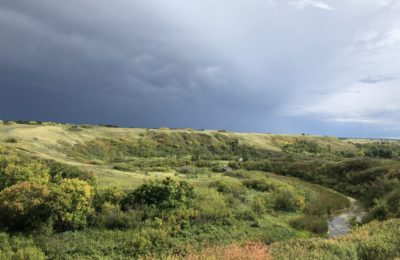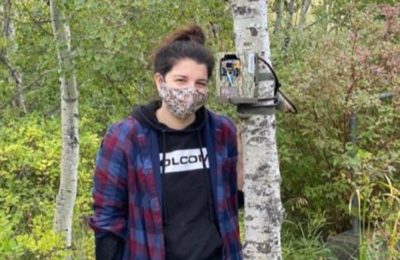Natural areas embedded within our cities provide us with multiple benefits.
From maintaining and restoring our health and well-being, to providing refuge for a variety of urban species, to helping safeguard us from a changing climate and extreme weather events; by maintaining, restoring, and preserving green spaces we are ensuring critically important ecological and cultural assets throughout our cities can thrive.
The Covid-19 pandemic has shed light on just how critically important the natural urban landscapes are for our health and wellbeing. Green, and especially natural and naturalized, spaces encourage people to interact with nature, engage in physical activity, and promote connection with the land and those around them, building a sense of community while playing a central role in the benefits to reducing stress from our busy lives.
While the concept of urban conservation has been brought to the fore these past couple of years, the benefits of accessible green spaces for our health are well known. Multiple studies have shown that nature is integral to mental, physical, and overall wellbeing. With 72% of Canadians living in urban spaces, prioritizing equitable and accessible green space is becoming increasingly important.
In addition to the importance of our own health and wellbeing, green spaces within cities provide economic benefits that stem from the ecological services that nature provides for free, while also bolstering resilience to climate change.
It is evident that climate change comes at a large cost when considering the damage caused by extreme weather events. By protecting nature within cities, we are helping to mitigate some of the costs associated with these events, as natural areas provide relief from extreme weather and help build more sustainable cities. The ecological benefits that nature provides are worth billions in economic value, and in some cases, can be priceless.
Some examples of benefits that urban green spaces provide:
- Cooling cities during extreme heat
- Purifying air from pollutants
- Filtering and absorbing water during heavy rains, mitigating floods
- Sequestering and storing carbon
- Habitat support for all kinds of biodiversity which provides additional ecosystem services, such as pollination, seed dispersal, nutrient cycling
Take Action
Preserve our Urban Nature
Threats to Urban Natural Areas

Urban expansion
Urbanization continues to expand rapidly outside the city core across large tracts of land. The spread of urban areas significantly reduces habitat availability and disrupts natural ecological processes.



Road construction
Increased road construction fragments existing habitat and corridors and increases the likelihood of vehicle-wildlife collisions.



Invasive Species
Urbanization of natural areas supports the widespread invasion of non-native species that outcompete native species.
Urban Conservation
What CPAWS is Doing?
CPAWS is actively engaged both locally and nationally on matters affecting urban conservation.
In Saskatoon, we have worked extensively with the Swale Watchers, Wild About Saskatoon, and others to raise the profile of the Northeast and Small Swale complexes, an area under significant pressure from urban development.
To learn more about Saskatoon's Northeast and Small Swales, visit this page.
We continue to work with the Meewasin Valley Authority, Parks Canada, and other local stakeholders on the development of a pan-Canadian National Urban Park program, and more broadly advocating for the protection, conservation, and connectivity of important cultural and ecological landscapes within the urban setting – for the benefit of people, their ecological services, and to the abundance of at-risk flora and fauna they support.
National Urban Park discussions:
During the summer of 2021, CPAWS-SK celebrated the news shared by the federal government to launch a series of urban parks across the country. The announcement being made in Saskatoon bore significant weight, as it is the first city to enter a collaborative agreement to work towards establishing a National Urban Park (NUP).
CPAWS-SK is excited to be involved in the engagement and planning process of the potential National Urban Park within Saskatoon. We are also engaged at a national level with Parks Canada, providing initial policy recommendations to a proposed pan-Canadian National Urban Park network. We will continue to engage with Parks Canada as this network evolves. We are ready to ensure that healthy, viable ecosystems and ecological integrity remain at the forefront of the planning process and that these areas form an integral part of any future NUP or are afforded the long-term protection they so rightly deserve.
Municipal Fund for Biodiversity:
Created with the purpose of being a solution and catalyst to investing in urban nature conservation through a collaborative approach, the Municipal Fund for Biodiversity - a CPAWS developed program - has the opportunity to advance a broad spectrum of projects linked to addressing biodiversity loss, the restoration, enhancement, and protection of natural urban landscapes, and to contribute to climate change adaptation and mitigation.
Over the past couple of years we have engaged with the City of Saskatoon – where the more recent National Urban Park engagement has moved this conversation forward – and the City of Prince Albert, where the protection and land use status of Little Red Park remains uncertain. We will continue to engage with both these cities on this Fund, to understand its complementary value to the NUP conversation, and how it could support and help protect the important ecological and cultural assets of Little Red Park.
We have not yet identified any key urban or near-urban areas within the City of Regina at this time that may benefit from this fund, but as the fund develops, we hope these important conversations can be broadened to Regina and other municipalities in Saskatchewan.








